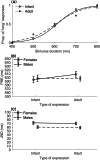Impact of babyface schema on time perception: Insights from neutral and crying facial expressions
- PMID: 38830603
- PMCID: PMC11169756
- DOI: 10.1002/pchj.766
Impact of babyface schema on time perception: Insights from neutral and crying facial expressions
Abstract
Facial expressions in infants have been noted to create a spatial attention bias when compared with adult faces. Yet, there is limited understanding of how adults perceive the timing of infant facial expressions. To investigate this, we used both infant and adult facial expressions in a temporal bisection task. In Experiment 1, we compared duration judgments of neutral infant and adult faces. The results revealed that participants felt that neutral infant faces lasted for a shorter time than neutral adult faces, independent of participant sex. Experiment 2 employed sad (crying) facial expressions. Here, the female participants perceived that the infants' faces were displayed for a longer duration than the adults' faces, whereas this distinction was not evident among the male participants. These findings highlight the influence of the babyface schema on time perception, nuanced by emotional context and sex-based individual variances.
Keywords: attention; duration perception; embodiment; infant facial expression; sex difference.
© 2024 The Authors. PsyCh Journal published by Institute of Psychology, Chinese Academy of Sciences and John Wiley & Sons Australia, Ltd.
Conflict of interest statement
The authors declared no potential conflicts of interest with respect to the research, authorship, and/or publication of this article.
Figures



References
-
- Bornstein, M. H. , Putnick, D. L. , Rigo, P. , Swain, J. E. , Suwalsky, J. T. D. , Su, X. , Du, X. , Zhang, K. , Cote, L. R. , De Pisapia, N. , & Venuti, P. (2017). Neurobiology of culturally common maternal responses to infant cry. Proceedings of the National Academy of Sciences of the United States of America, 114(45), E9465–E9473. 10.1073/pnas.1712022114 - DOI - PMC - PubMed
-
- Bowlby, J. (1969). Attachment and loss: Attachment (Vol. 1). Basic Books.
MeSH terms
Grants and funding
LinkOut - more resources
Full Text Sources

